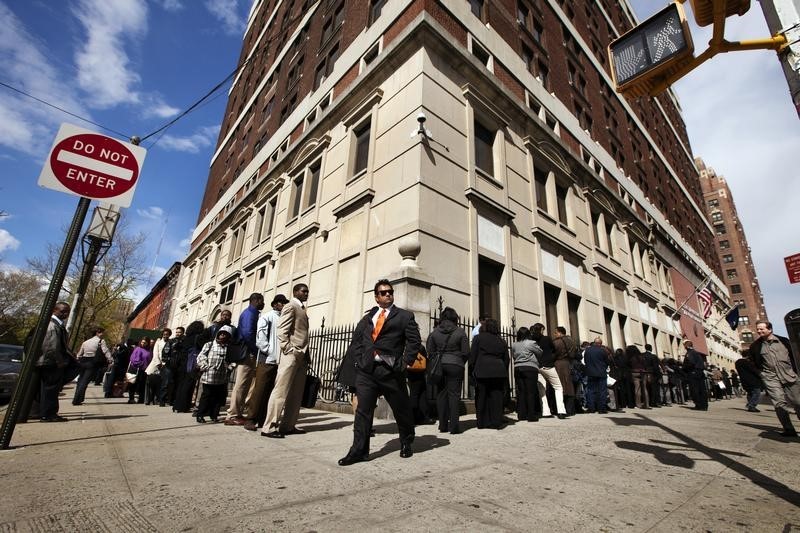(Bloomberg) -- U.S. employment figures for September showed an economic recovery that’s becoming increasingly shaky without a Covid-19 vaccine or fresh government aid.
The weaker-than-forecast headline gain in payrolls left the U.S. 10.7 million jobs shy of February’s total, and Friday’s report evinced other troubling trends: People who permanently lost a job hit a seven-year high. Women -- and some men, too -- streamed out of the labor force as school closures forced parents to stay home. And long-term unemployment rose as many Americans remained out of work six months after the pandemic began spurring job losses.
Read more: Women Drop Out of Workforce at Fastest Pace Since Pandemic Peak
The numbers -- the last before Election Day -- landed hours after the country was plunged further into uncertainty by President Donald Trump’s coronavirus diagnosis. Lawmakers remain at odds over further stimulus to help jobless Americans and small businesses, though the latest numbers could add pressure to agree on a package. House Speaker Nancy Pelosi said Friday that she’s “optimistic” a deal will be reached.
“Labor-market momentum is slowing,” said Michael Gapen, chief U.S. economist at Barclays (LON:BARC) Plc. From now on, recovering lost output “has to mainly come from services -- that’s going to be hard when we don’t have a vaccine and there’s still a large number of Covid cases.”
The 661,000 increase in nonfarm payrolls followed an upwardly revised 1.49 million advance in August. The median estimate of economists for a gain of 859,000.
While the unemployment rate fell by more than forecast, dropping 0.5 percentage point to 7.9%, the labor-force participation rate declined by 0.3 point to 61.4%, with the decrease particularly pronounced among women.
The labor participation rate for so-called prime-age women, between ages 25 and 54, fell for a third straight month, by 0.7 percentage point -- the fastest pace since the height of the pandemic. That figure -- which reflects those employed, plus the jobless who are actively looking for work, as a share of the population -- signals parents are increasingly leaving their jobs due to childcare obligations.
What Bloomberg’s Economists Say
“At 7.9% in September, the unemployment rate is fast approaching the Fed’s forecast for year-end (7.6%). However, it is unlikely to comfort the central bank, given that Americans continue to leave the labor force at an alarming pace.”
-- Yelena Shulyatyeva, Andrew Husby and Eliza Winger
Read more for the full reaction note.
“A drop in participation is unequivocally bad for the labor-market outlook,” said Sarah House, senior economist at Wells Fargo (NYSE:WFC) & Co. “It has the potential to prolong the overall recovery as workers are more disengaged with the labor market.”
Also, weak gains in average hourly earnings -- which rose a less-than-expected 0.1% in September from the prior month -- are “another land mine for the spending of consumers going forward given overall slower job growth” and fading fiscal support, she said.
One of the key drivers of September’s payrolls figure was a 280,500 seasonally-adjusted drop in employment in state and local education, as budget cuts along with a switch to virtual education in many districts weighed on hiring. On an unadjusted basis, that figure actually rose, though by much less than typical for the start of the school year.
Failure to pass additional stimulus could also spur further cuts in state and local government jobs.
Federal government employment fell by 34,000 in September, reflecting a drop in temporary Census workers in the month, after hiring of such employees gave a 238,000 boost in August.
The number of Americans who were classified as long-term unemployed jumped by 781,000 last month to 2.4 million. The category, which includes those actively searching for work for 27 weeks or longer, underscores the lasting economic scars many Americans will have after months of joblessness.
Read More:
- One Day, Thousands of Job Cuts: Economic Pain Is Deepening
- American, United to Cut Combined 32,000 Jobs Amid U.S. Aid Talks
- Stressed U.S. Cities See Slim Shot at Covid Relief After Shutout
- Women Who Helped Pull U.S. Out of Last Recession Now Fall Behind
- Women Drop Out of Workforce at Fastest Clip Since Virus Peak
Industries including oil, entertainment and financial services are all home to major companies announcing job cuts in recent days, which will take some time to show up in official data.
“Until you can return to normal activity, you’re going to have people unemployed for longer periods of time,” said Brett Ryan, senior U.S. economist at Deutsche Bank AG (NYSE:DB). “If businesses don’t come back, it’s going to keep the unemployment rate elevated.”
©2020 Bloomberg L.P.
